Folk dances of Rajasthan trace their origin to rural customs and traditions. These dances form an integral part of people’s lives and are performed on important occasions and festivals. The rise of princely states during medieval times, also added to growth of folk dances, as the rulers gave patronage to art & crafts. Jaipur Gharana is supposedly the first gharana of Kathak dance. Its pioneer was Bhanuji.
Folk Dances of Rajasthan
Bhavai Folk Dance:
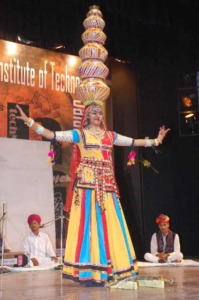 Location:
Location:
- Udaipur, Chittorgarh, Banswara, Dungarpur
- Performed By:
- Skilled male or female dancers
- Performance Occassion:
- Marriages
- Features:
- Bhavai dance basically involves women dancers balancing 8 to 9 earthen-pots (matki’s) on their heads and dancing simultaneously.
- Additionally, dancers also put their feet on the top of a glass pieces or on the edge of a naked sword or on the rim os a brass thali (plate) during the performance.
- Famous Persons associated with dance form:
- Mrs.Krishna Vyas Chhangani, from Jodhpur (Rajasthan).
Chari Folk Dance:
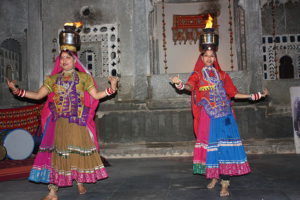 Location:
Location:
- Kishangarh
- Performed By:
- Women from Gujjar Community
- Performance Occasions:
- Marriage occasions, on the birth of a male child or any big festival celebration.
- Features:
- This dance describes the art of collecting water in a chari or pot by the Rajasthani women in their day to day life.
- These ladies carry brass pots on their heads balancing it to perfection. These pots are kept ignited with the cotton seeds dipped in oil. These lit pots display beautiful effect in the dark night.
- Famous Persons associated with dance form:
- Falku Bai
Chakri Folk Dance
Chakri dance is believed as same as the Raai dance of ‘Beriyas’ tribe of Madhya Pradesh. Devi Lal Sagar made this dance popular.
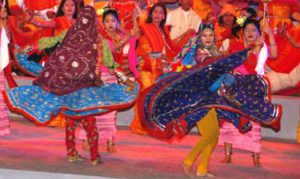 Location:
Location:
- Hadoti region of Bundi, Kota & Baran District.
- Performed By:
- Women of Kanjar tribe
- Performance Occasions:
- Marriages & Festivals of Hadoti Region.
- Features:
- As the name suggests, Chakri dance involves a series of fast and vigorous spinning movements with the beats of the Dholak.
- Famous Persons associated with dance form:
- Shanti Devi, Phulwa Filma
Drum Folk Dance:
The credit for bringing this dance to limelight goes to Jay Narayan Vyas.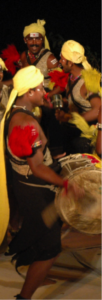
- Location:
- Jalore
- Performed By:
- Only Men
- Performance Occasions:
- Marriages
- Features:
- In this dance, five men beat huge drums that are tied around their necks.
- One dancer holding a huge cymbals in their hands, also accompany the drummers.
- One dancer holds a naked sword on his mouth and juggle with other three dancers.
Folk Dances of Rajasthan
Fire Folk Dance:
 Location & Performed By:
Location & Performed By:
- Jasnathis of Bikaner and Churu districts of Rajasthan India.
- Performance Occasions:
- On the festive occasions like Holi, Janmashtami etc.
- Features:
- Jasnathi men and boys jump on to the fire with the accompaniment of drum beats.
- The dance involves breathtaking fire stunts wherein the dancers perform by holding fire rods in their hands and filling up their mouths with kerosene.
- The fire rods are also moved on their heads and legs by the dancers.
- Dancers move on top of flaming bed of charcoal.
Gair Folk Dance:
 Location:
Location:
- Performed in Mewar region. However, its variations like the Dandi Gair is found in the Marwar region and Geendad is found in the Sehkhawati region
- Performed By:
- Both men and women dance together of Bhil tribe
- Performance Occasions:
- Holi
- Features:
- The Gair dance is performed by both Men and Womenfolk holding wooden sticks
- It is group dance consisting of two circles where groups of dancers moving in and out a big circle.
- According to rhythm, they perform various steps, striking their sticks & take turns in-between.
Gawri Folk Dance:
 Location:
Location:
- Udaipur, Rajsamand and Chittorgarh districts of Rajasthan
- Performed By:
- Gawri is a dance drama of Bhil Tribe
- Performance Occasions:
- After the monsoons, in the months of September and October
- Features:
- This tribal dance has a troupe which travel through village to village with their dance for a month.
- Gawari expresses the devotion and faith to Lord Shiva and his wife Parvati through Folk Dance, Music and Folklores.
- It also symbolizes human love for forests, animals and people.
- Women do not take part in Gavri and all the female roles are played by men.
Ghoomar Folk Dance:
 Location:
Location:
- Across Rajasthan
- Performed By:
- Originally by Bhil Community, adopted by different communities including Rajputs (Women).
- Performance Occasions:
- Rajput Marriages
- Features:
- Ghoomar is a very simple dance where the dancers move gently and gracefully in circles.
- Dancing includes pirouetting which displays the spectacular colors of the flowing ‘ghaghara’, the long skirt of the Rajasthani women.
Kachi Ghodi Folk Dance:
 Location:
Location:
- Shekhawati
- Performed By:
- Men
- Performance Occasions:
- Generally performed for the entertainment of the bridegroom’s party, Holi.
- Features:
- This dance is performed by mens on dummy horses. Men wear elaborate costumes- red turbans and dhotis and kurtas, embellished with brilliant mirror-work and ride the dummy horses. These dancers move rhythmically to the beating of drums and fifes by holding a naked sword on the hand while a singer narrates the exploits of the Bavaria bandits of Shekhawati region through his song.
Folk Dances of Rajasthan
Kalbelia Folk Dance:
Kalbelia dance is included in UNESCO’s list of the Cultural Heritage of Humanity from the year 2010
 Location:
Location:
- Pali district, Ajmer, Chittorgarh and Udaipur district.
- Performed By:
- Women from Kalbelia community.
- Performance Occasions:
- Kalbelia songs are based on stories taken from folklore and mythology and special dances are performed during Holi.
- Features:
- The dancers are women in flowing black skirts who dance and swirl, replicating the movements of a serpent.
- The cloths are mixed in red and black hues and embroidered in unique patterns.
- Kalbelia dance has a traditional musical instruments which is Poongi also called Been. Other traditional musical instruments used by Kalbelia tribe in Kalbelia dance are Dufli, Morchang, Dholak, Khanjari and Khuralio.
Kathputli Folk Dance:
Kathputli Dance means the dances of puppets. It is a traditional dance of Indian state of Rajasthan. Kathputli is a join of two rajasthani language words Kath meaning wood and Putli meaning a doll which has no life , hence Kathputli means a doll made of wood. Kathputli are usually made of mango wood and stuffed with cotton. These puppets are generally one and half feet in height and are made in Sawai-Madhopur, Bari, and Udaipur.
 Location:
Location:
- Performed across Rajasthan.
- Performed By:
- Kathputli Art & Dance is believed to be initiated 1000 years back by Bhat Community.
- Performance Occasions:
- All Festive Occasions
- Features:
- Kathputli is not just source of entertainment but also they taught society the social and moral education.
- These acts of puppetry portrayed major social issues like stories from mythology, folklores, historical heroes.
- Famous Persons associated with dance form:
- Organisations: Rupayan Sansthan in Jodhpur founded by Vijaydan Detha and Komal Kothari in 1960 and Bharatiya Lok Kala Mandal, Udaipur, founded by Devilal Samar in 1952, are working in the field preserving and promoting the art of Kathputli.
- New Delhi also has an area known as ‘Kathputli Colony’, in Shadipur Depot, where puppeteers have lived long.
Terah Taali Folk Dance:
 Location:
Location:
- Ramdevra, Dindwana, Dungarpur, Udaipur
- Performed By:
- Woman from Kamad tribe while sitting on the floor before Baba Ramdeo’s image.
- Performance Occasions:
- In honor the folk hero, Baba Ramdeo
- Features:
- The women have 13 ‘manjeeras‘ (little brass discs) tied to the various parts of their body, which they strike with the ones they hold in their hand.
- Often a swords is also used by the professional Terah Taali dancer and also a pot on her to make the dance more attractive.
- Male artists sings local Rajasthani folk songs as a background music and play different instruments like pakhwaja, dholak jhanjhar, sarangi, harmonium etc.
- Famous Persons associated with dance form:
- Mangi Bai, Mohni Narayani, laxman das kamad
Walar Folk Dance:
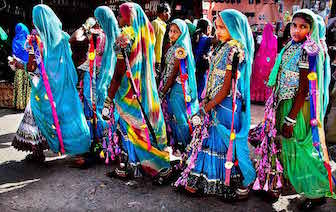 Location:
Location:
- Udaipur, Pindwara(Sirohi), Abu Road
- Performed By:
- Women from Garasia community
- Performance Occasions:
- On occasion of gangaur & teej festivals.
- Features:
- Involves simple circular movements of dancers on beats.
- Generally accompanied by the beats of the mandal, chang and a variety of other musical instruments.
Folk Dances of Rajasthan | Folk Dances of Rajasthan
